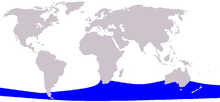Pygmy right whale
| Pygmy right whale | |
|---|---|
 |
|
 |
|
| Size compared to an average human | |
| Scientific classification | |
| Kingdom: | Animalia |
| Phylum: | Chordata |
| Class: | Mammalia |
| Order: | Artiodactyla |
| Infraorder: | Cetacea |
| Family: | Cetotheriidae |
| Subfamily: |
Neobalaeninae (Gray, 1873) |
| Genus: |
Caperea Gray, 1864 |
| Species: | C. marginata |
| Binomial name | |
|
Caperea marginata (Gray, 1846) |
|
 |
|
| Pygmy right whale range | |
The pygmy right whale (Caperea marginata) is a member of the cetotheres, a family of baleen whales, which until 2012 were thought to be extinct; previously C. marginata was considered the sole member of the family Neobalaenidae. First described by John Edward Gray in 1846, it is the smallest of the baleen whales, ranging between 6 and 6.5 metres (20 and 21 ft) in length and 3,000 and 3,500 kilograms (6,600 and 7,700 lb) in mass. Despite its name, the pygmy right whale may have more in common with the gray whale and rorquals than the bowhead and right whales.
The pygmy right whale is found in the Southern Ocean in the lower reaches of the Southern Hemisphere, and feeds on copepods and euphausiids. Little is known about its population or social habits. Unlike most other baleen whales, it has rarely been subject to exploitation.
During the 1839-43 voyage of James Clark Ross, naturalists found bones and baleen plates resembling a smaller version of the right whale. In his Zoology of the Voyage of HMS Erebus and Terror (1846), John Edward Gray described the new species, naming it Balaena marginata. In 1864, Gray established a new genus (Caperea) after receiving a skull and some bones of another specimen. Six years later, in 1870, he added the name Neobalaena. He soon realized the three species were one and the same: Caperea marginata (caperea means "wrinkle" in Latin, "referring to the wrinkled appearance of the ear bone"; while marginata translates to "enclosed with a border", which "refers to the dark border around the baleen plates of some individuals"). In research findings published on December 18, 2012, paleontologist Felix Marx compared the skull bones of pygmy right whales to those of other extinct cetaceans, finding it to be a close relative to the Cetotheriidae, making the pygmy right whale a living fossil.
...
Wikipedia

